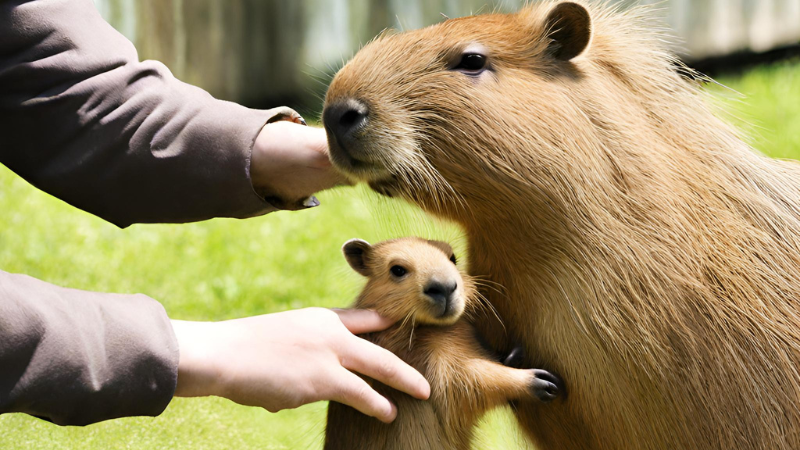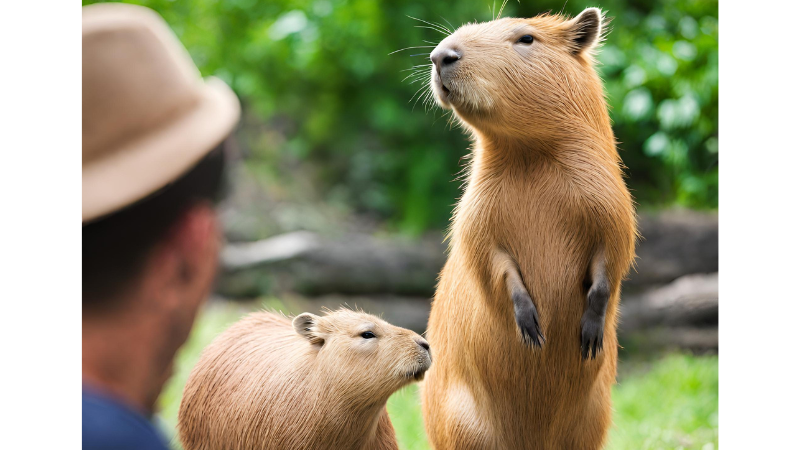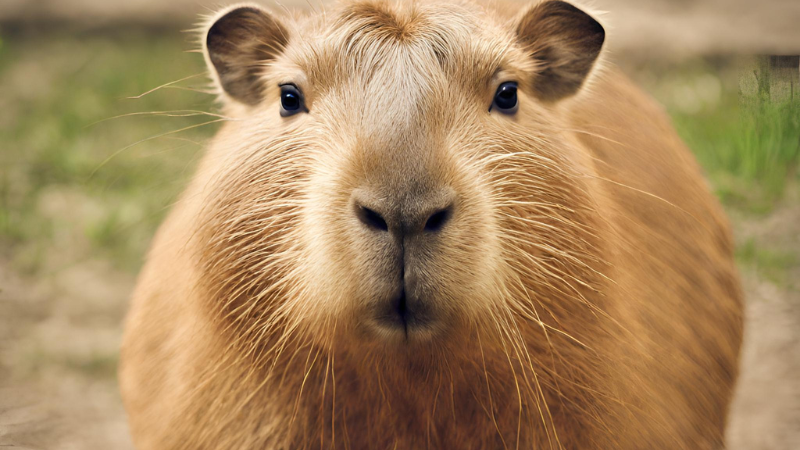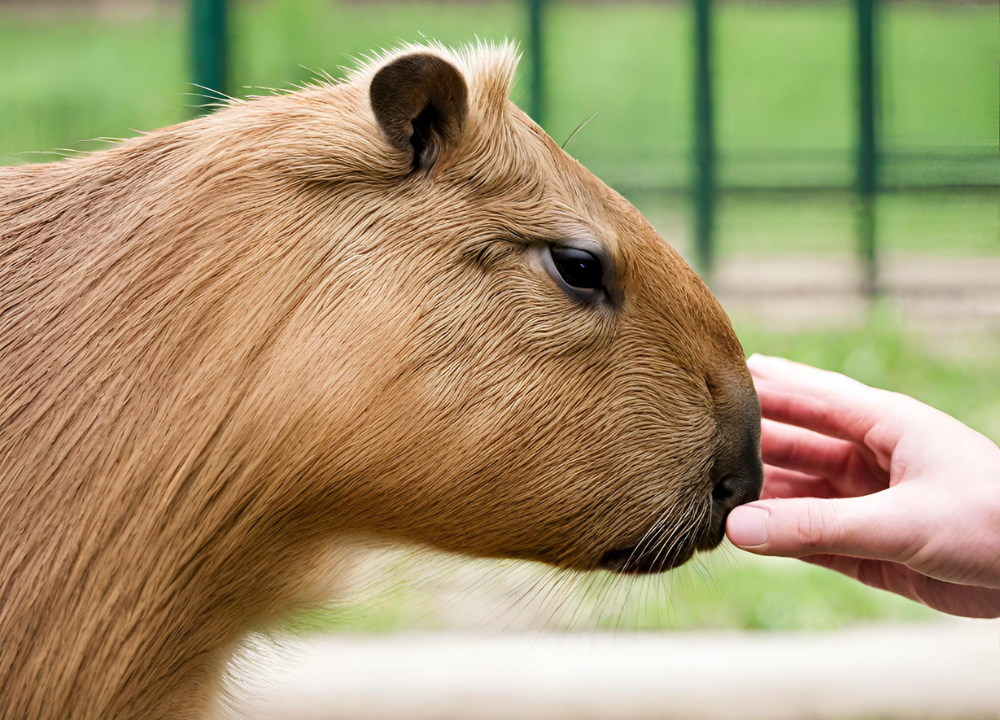Capybaras can be petted in designated facilities such as zoos or animal sanctuaries. These facilities offer a safe and controlled environment for visitors to interact with capybaras.
If you’ve ever been curious about getting up close and personal with a capybara, you might be wondering where you can actually pet one. Capybaras, which are native to South America, are fascinating creatures known for their friendly and sociable nature.
Despite their large size, they are gentle and often enjoy being around humans. While it’s not common to have capybaras as pets in homes, there are places where you can have the opportunity to pet and interact with these adorable animals. We will explore some of the places where you can satisfy your curiosity and get the chance to pet a capybara.
Places To Pet Capybaras In The Wild
If you’re an animal lover with a curiosity about capybaras, you might be wondering where you can actually pet these fascinating creatures in their natural habitat. In this section, we’ll explore some of the top places where you can have an up-close encounter with capybaras in the wild.
Capybara Natural Habitat
Capybaras are native to South America, specifically the vast grasslands and wetlands of the continent. These semi-aquatic rodents can be found in countries such as Brazil, Argentina, Uruguay, and Paraguay, where they thrive in habitats with plenty of water sources like rivers, swamps, and lakes.
Exploring the capybara natural habitat is an incredible opportunity to see these creatures in their element. With their social behavior and relaxed nature, they often gather in groups near water bodies, basking in the sun or taking a leisurely dip to cool off. However, it’s important to remember that in the wild, capybaras are not accustomed to human interaction and, therefore, should be observed from a respectful distance to avoid disturbing their natural behavior.
Wildlife Reserves And National Parks
If you’re keen on petting capybaras while still ensuring their well-being and conservation, visiting wildlife reserves and national parks is a great option. These protected areas provide an opportunity to observe and learn about capybaras in their natural habitat with the guidance of experienced wildlife experts.
Many wildlife reserves and national parks offer guided tours or designated observation areas where visitors can witness capybaras in their natural environment without causing harm or disturbance. These controlled settings prioritize the welfare of the animals while allowing people to appreciate their beauty up close.
Capybara Sanctuaries
Capybara sanctuaries provide a unique opportunity for animal enthusiasts to get hands-on experience with these charismatic creatures while supporting their conservation efforts. These sanctuaries typically rescue and rehabilitate injured or abandoned capybaras, using their facilities to provide a safe and nurturing environment for these animals.
At capybara sanctuaries, visitors can interact with the animals under the guidance and supervision of trained staff members. Here, you’ll not only have the chance to pet capybaras but also learn about their behavior, diet, and the challenges they face in the wild. These sanctuaries play a crucial role in raising awareness about capybara conservation while providing a unique and memorable experience for visitors.

Interactive Animal Farms And Zoos
If you’re a fan of interactive animal experiences, visiting a petting zoo, farm, or exotic animal encounter facility can be an exciting way to satisfy your curiosity and get up close with unique creatures like capybaras. These interactive animal establishments offer a chance to not only see these fascinating animals but also to pet and interact with them in a safe and controlled environment. In this section, we will explore three types of interactive animal farms and zoos where you can have the opportunity to pet a capybara.
Petting Zoos With Capybaras
When it comes to hands-on animal encounters, petting zoos are often the go-to choice for animal enthusiasts. Petting zoos provide a safe and educational environment where visitors of all ages can learn about and interact with a variety of animals, including capybaras. These cuddly and sociable creatures are often the stars of the petting zoo, where visitors have the chance to pet and feed them.
At these petting zoos, capybaras roam freely in their designated areas, surrounded by fences or enclosures to maintain a safe distance for both visitors and the animals. Visitors can approach these gentle giants, stroke their silky fur, and even interact with them under the supervision of trained staff.
If you’re planning a visit to a petting zoo with capybaras, keep in mind that each facility may have different guidelines and regulations. Some zoos might require visitors to wash their hands before and after touching the animals, while others provide specific feeding times to ensure the capybaras’ health and well-being.
Farms With Capybaras
If you want a more immersive experience with capybaras, visiting a farm might be the perfect choice. Farms with capybaras offer a unique opportunity to learn about these fascinating creatures and witness their daily lives in a natural setting.
Unlike petting zoos, farms allow visitors to observe capybaras in their habitats and provide a more hands-off experience. You can typically find capybara farms associated with animal conservation efforts or educational institutions where the animals receive proper care and attention.
During your visit, you’ll have the chance to see capybaras in their natural behaviors, from soaking in water to mingling with other farm animals. Farms often offer guided tours or informational sessions to educate visitors about the characteristics, habitat, and conservation efforts related to these adorable animals. While you may not be able to pet the capybaras directly, the farm experience provides a deeper understanding and appreciation for their important role in our ecosystems.
Exotic Animal Encounter Facilities
If you’re looking for a truly one-of-a-kind experience with capybaras and other exotic animals, consider visiting an exotic animal encounter facility. These facilities specialize in providing unique and close-up encounters with animals from around the world, including capybaras.
Exotic animal encounter facilities often offer interactive programs and guided tours that allow visitors to get up close and personal with capybaras. You may have the opportunity to pet, feed, and even hold these gentle creatures while learning interesting facts about their behavior and natural habitats.
These facilities prioritize the well-being and safety of their animals, adhering to strict guidelines and regulations. Trained staff members are on hand to ensure the animals’ welfare while providing visitors with an unforgettable experience.
| Interactive Animal Establishments | Type of Interaction |
|---|---|
| Petting Zoos | Pet, feed, and interact with capybaras under supervision |
| Farms | Observe capybaras in their natural habitat and learn about conservation efforts |
| Exotic Animal Encounter Facilities | Unique and up-close encounters with capybaras and other exotic animals |
In conclusion, interactive animal farms and zoos offer a range of opportunities to pet and interact with capybaras. Whether you choose to visit a petting zoo, a farm, or an exotic animal encounter facility, you’ll have the chance to get to know these fascinating creatures and create memorable experiences. Just remember to follow any guidelines or regulations set by the establishment to ensure both your safety and the well-being of the capybaras.

Unique Capybara Experiences
Discover unique and exciting ways to interact with capybaras and satisfy your curiosity. From petting experiences to exclusive encounters, explore the opportunities available to get up close and personal with these fascinating creatures.
If you’re wondering where you can have a memorable encounter with a capybara, there are several unique opportunities available. From cozy cafes to specialized therapy centers, these experiences will not only satisfy your curiosity but also create lasting memories. Let’s explore these options:
Capybara Cafe
The Capybara Cafe is a haven for animal lovers seeking an extraordinary encounter with these adorable creatures. Nestled in a tranquil setting, this café offers visitors a chance to relax, sip their favorite beverages, and enjoy the company of friendly capybaras. Watch as they leisurely roam around, nibbling on treats, and occasionally seeking gentle pats. It’s a rare opportunity to get up close and personal with these fascinating creatures while indulging in a warm cup of coffee.
Animal Therapy Centers
Animal therapy centers have recognized the calming influence and therapeutic benefits that capybaras can offer. These centers provide a unique space for individuals seeking emotional support or stress relief. Capybaras, known for their affectionate nature and soothing presence, are ideal companions for this purpose. By petting and interacting with these gentle creatures, visitors often experience a sense of tranquility and connection that can be truly transformative.
Educational Institutions
Many educational institutions, including zoos, nature reserves, and children’s museums, offer opportunities to interact with capybaras in an educational and informative setting. These institutions not only aim to entertain but also to enlighten visitors about the fascinating world of capybaras. Often, you can participate in interactive sessions where knowledgeable guides provide valuable insights into the capybara’s behavior, habitat, and conservation efforts. These experiences are perfect for those curious minds who want to learn more about capybaras and their role in the natural ecosystem.

Precautions For Petting Capybaras
Before getting up close and personal with these fascinating creatures, it’s important to take some precautions to ensure a safe and enjoyable experience for both you and the capybara in question. Understanding capybara behavior, following safety guidelines, and respecting their boundaries are key factors to consider for a successful interaction.
Understanding Capybara Behavior
When it comes to petting capybaras, having a good understanding of their behavior is crucial. Capybaras are naturally social animals and can be friendly and affectionate. However, they also have their limits and boundaries. It’s important to recognize and interpret their body language to avoid any potential risks or discomfort. Here are a few cues to look out for:
- Relaxed posture: A calm and relaxed capybara will have a loose and easygoing body posture. They may lay down, roll, or sit while inviting you for a petting session.
- Back arching: When a capybara arches its back and raises its head, it’s an indication that they are not interested in being touched at the moment. Respect their boundaries and give them space.
- Growling or hissing: If a capybara makes growling or hissing sounds, it’s a clear indication that they are feeling threatened or annoyed. Back off immediately and give them time to calm down.
Following Safety Guidelines
Petting capybaras can be a delightful experience, but it’s crucial to ensure your safety as well as theirs. Here are some essential safety guidelines to follow:
- Approach capybaras slowly and gently, allowing them to become comfortable with your presence.
- Always stroke the capybara on their back or sides, avoiding sensitive areas such as their face, tail, or belly.
- Do not lift or carry capybaras without proper training and guidance. They are heavy animals and can get injured if handled incorrectly.
- Wash your hands thoroughly before and after handling capybaras to prevent the transmission of bacteria or diseases.
- Never startle or surprise a capybara, as sudden movements can frighten them and potentially lead to aggressive behavior.
Respecting Boundaries
While capybaras are known for being sociable, they still need their personal space. Respecting their boundaries is crucial to maintaining a positive and safe interaction. Here are a few key points to keep in mind:
- Avoid overcrowding: Limit the number of people interacting with the capybara at one time to prevent overwhelming them.
- Listen to the capybara: If the capybara shows signs of disinterest or discomfort, such as moving away or vocalizing, it’s important to respect their signals and give them space.
- Observe time limitations: Keep petting sessions short and sweet, as prolonged interaction can lead to stress or agitation for the capybara.
By understanding capybara behavior, following safety guidelines, and respecting their boundaries, you can enjoy a fulfilling and memorable experience while petting these extraordinary animals. Remember, they are wild creatures and should always be treated with the utmost care and respect.
Ethical Considerations
When it comes to interacting with capybaras, it is important to take ethical considerations into account. These gentle creatures deserve to be treated with respect, and responsible tourism plays a crucial role in ensuring their well-being. In this section, we will explore some key aspects of ethical considerations when petting capybaras.
Responsible Tourism
Responsible tourism is the foundation of ethical capybara petting experiences. It involves engaging in activities that have a positive impact on the animals and their habitats, while respecting their natural behaviors and environments. By choosing responsible tour operators and destinations, you can ensure that your encounter with these charming creatures supports conservation efforts and promotes their welfare.
Here are some practices to look for when engaging in responsible tourism:
- Opt for well-regulated and licensed facilities that prioritize the health and well-being of capybaras.
- Support sanctuaries that rescue and rehabilitate capybaras, as well as those involved in conservation efforts.
- Choose experiences that prioritize education and awareness, as this helps to promote a deeper understanding of the species.
- Respect the personal space and boundaries of capybaras, ensuring that they have the freedom to retreat if they desire.
- Follow any guidelines or rules provided by the tour operators or facility staff to minimize disturbance to the animals.
Conservation Efforts
Conservation plays a vital role in protecting capybaras and their natural habitats. By supporting conservation efforts, you contribute to the long-term survival of these unique creatures. Many organizations work tirelessly to protect capybaras from habitat loss, poaching, and other threats. When searching for opportunities to interact with capybaras, consider those that support conservation initiatives.
Here are some ways in which your petting experiences can contribute to vital conservation efforts:
- Choose facilities that allocate a portion of their proceeds to conservation projects, such as habitat preservation or funding scientific research.
- Engage in educational programs offered by a facility, as they often play a crucial role in raising awareness about capybara conservation.
- Volunteer at sanctuaries or organizations involved in capybara conservation to directly contribute to their well-being and protection.
- Donate to reputable organizations that focus on capybara conservation, ensuring your contribution has a positive, lasting impact.
Balancing Personal Interests
While it’s undoubtedly exciting to have the opportunity to pet a capybara, it is equally important to balance personal interests with the welfare of these animals. Before embarking on a petting experience, take the time to reflect on your intentions and motivations. Consider whether your desire for interaction aligns with the well-being and conservation needs of capybaras.
Here are some key factors to consider when balancing personal interests:
- Reflect on the facilities’ values and practices to ensure they prioritize the welfare and conservation of capybaras.
- Think about the impact of your visit on the capybaras and their natural behaviors. Avoid activities that may cause stress or disturbance.
- Support experiences that focus on observation and appreciation of capybaras within their natural habitats, respecting their wild characteristics.
- Educate yourself about capybara behavior and biology to enhance your understanding and appreciation of these marvelous creatures.
- Consider alternative ways to contribute to capybara conservation, such as donating or supporting projects from afar if petting is not feasible.
Things To Know Before Petting A Capybara
Before you embark on your journey to pet a capybara, it’s important to equip yourself with some essential knowledge. These adorable creatures may seem approachable, but there are certain factors you should consider for a safe and enjoyable experience. From understanding their characteristics to assessing the legal aspects and ensuring proper health and hygiene, here are seven things to know before you indulge in the joy of petting a capybara:
Capybara Characteristics
Capybaras are the largest rodents in the world, boasting a unique set of characteristics that make them fascinating animals to interact with. Understanding their behavior, needs, and preferences is crucial for a successful and meaningful petting session. Here are key capybara characteristics to keep in mind:
- Herbivorous Diet: Capybaras are strict herbivores, so it’s important to offer them a diet rich in fruits, vegetables, and hay.
- Semi-Aquatic Nature: Capybaras have a strong affinity for water, so it’s recommended to provide them with a shallow pool or access to a pond for their bathing and swimming needs.
- Social Behavior: Capybaras are highly social animals and thrive in groups. Keeping them solitary may lead to stress and behavioral issues, so it’s best to consider adopting a pair or creating a suitable social environment.
- Gentle Temperament: While capybaras are generally friendly and docile, it’s crucial to approach them with respect and gentle behavior. Quick movements or aggression can scare them or cause them to defend themselves.
Legal Aspects
Before petting a capybara, it’s important to ensure you are adhering to the legal aspects related to owning and interacting with exotic animals. These regulations may vary from country to country and even within different states or regions. Here are some legal considerations:
| Legal Aspects | Description |
|---|---|
| Permits and Licenses: | Check local regulations to determine if you need any permits or licenses to own or interact with capybaras. Authorities may have specific requirements to ensure the animal’s welfare and your compliance. |
| Prohibited Areas: | Some areas may have specific bans on petting or owning capybaras, so it’s essential to familiarize yourself with local laws to avoid any legal complications. |
| Health Certificates: | Ensure the capybara you are interacting with has proper health certificates and vaccinations, as mandated by local authorities. This will ensure both your safety and the well-being of the animal. |
Health And Hygiene
Keeping a capybara healthy and maintaining proper hygiene is crucial for the well-being of both the animal and yourself. Before petting a capybara, consider the following health and hygiene factors:
- Veterinary Care: Find a qualified exotic veterinarian who specializes in capybara care. Regular check-ups, vaccinations, and proper medical care are essential for keeping these animals happy and healthy.
- Parasite Prevention: Capybaras can be susceptible to various parasites, so discuss with your veterinarian the best practices for parasite prevention, including regular deworming.
- Personal Hygiene: Before and after interacting with a capybara, ensure you practice proper personal hygiene. Wash your hands thoroughly with soap and water to minimize the risk of transmission of any potential diseases.
By arming yourself with these crucial insights about capybara characteristics, legal aspects, and health and hygiene considerations, you can safely and responsibly enjoy the experience of petting these fascinating creatures. With the right knowledge and preparation, the joy of bonding with a capybara can be a memorable and enriching experience.
Frequently Asked Questions For Satisfy Your Curiosity: Where Can I Pet A Capybara?
Where In The Us Can You Pet Capybaras?
In the US, there are limited places where you can pet capybaras. Some interactive animal exhibits, petting zoos, and specialized wildlife sanctuaries may offer this unique experience. Remember to check locally for specific locations and guidelines before visiting.
Where Do Capybaras Like To Be Petted?
Capybaras enjoy being petted on their back and sides. They prefer gentle strokes and scratches.
Where Can I Find Capybara?
Capybaras can be found in South America, particularly in countries like Brazil, Venezuela, and Colombia. They inhabit various habitats such as forests, grasslands, and wetlands.
Is It Okay To Pet A Capybara?
Yes, it’s okay to pet a capybara. They are friendly animals that enjoy human interaction. However, make sure to approach them gently and give them space if they show signs of discomfort. It’s always important to respect their boundaries for their well-being.
Conclusion
To conclude, if you’re itching to interact with a capybara, you’ll be glad to know that various options exist. Zoos, wildlife sanctuaries, and petting farms often offer opportunities to get up close and personal with these fascinating creatures. Just ensure that you respect their space and follow any guidelines provided to ensure both your safety and the capybara’s well-being.
So, go ahead and satisfy your curiosity by finding a suitable location near you where you can pet a capybara. Happy exploring!







